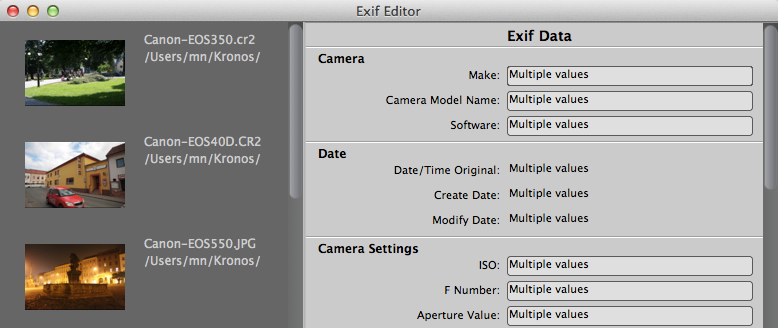

- #Exif editor for mac os x how to
- #Exif editor for mac os x update
- #Exif editor for mac os x manual
- #Exif editor for mac os x upgrade
- #Exif editor for mac os x download
If you're upgrading to Photos for Mac from iPhoto and you've only ever had a single iPhoto library on your Mac, your upgrade path is easy: After you open the app for the first time, Photos will automatically import all your iPhoto images into the app.


#Exif editor for mac os x how to
How to import your iPhoto Library into Photos for macOS If you have a single iPhoto Library How to copy imported files to your Photos libraryĭoing this means only items copied to the library will be uploaded to iCloud Photos. There's another important reason to do this if you plan to share those imported images on other devices: Only items copied to Photos' library will be uploaded to iCloud Photo Library. To put everything actually in your Photos library, make sure to modify Photos' preferences to copy imported files to your Photos library. This is a double-edged sword: It reduces the size of Photos' library but if your goal is to clean up folders and disks with lots of photos on them, it can get confusing. It keeps links to them, so you can use Photos to edit or catalog them but still keep them where they are. In the Finder, you can also simply drag and drop the images you want to import onto the Photos icon Photos will import them.īear in mind, though, that Photos' default behavior is not to include original images in imports. The file will now be added to your Photos library. Open Photos from your Dock or Applications folder.Here's what you need to know about bringing your older pictures and libraries to Photos for Mac. How to sync your Lightroom exports with Photos on Mac How to import images and folders into PhotosĪfter you've gotten Photos set up, the next step is to import your images. Just note down where they're stored on your hard drive, and then import away. If you switched to Lightroom a while ago but now want to make the move to Photos, your best bet is to load your Lightroom folders and files directly into Photos. A note for Lightroom users looking to switch
#Exif editor for mac os x manual
However, there is no real good way to import an existing Aperture library into Photos aside from a manual migration. If you need to do this, you can use Aperture first to consolidate libraries, then import that unified library into Photos. Unfortunately, you can't consolidate multiple libraries into a single Photos library - you have to pick which one you want to use. If you had multiple libraries on your machine, Photos will ask you to select which library you'd like to import. Your old iPhoto library will still remain if you need to use iPhoto for whatever reason, but changes made to those older images won't automatically sync to your new Photos library. If you only had a single iPhoto library on your Mac, it should upgrade automatically as soon as you open the Photos app. If you've been resisting the transition, but have finally decided to switch to Photos on the Mac, it isn't as painful as you might think. Until then, you should keep your Aperture library and expect to migrate it to Photos again.Īpple announced in 2014 that it would no longer continue developing for iPhoto or Aperture, its older photo storage and editing programs for the Mac.
#Exif editor for mac os x update
Apple will be releasing an update to macOS Catalina that will address this issue. You will still be able to use Photos to choose your Aperture library as demonstrated below, but this may only show the original photos and not any edits you've made. User-interface and tagging are fully Unicode compliant.As of macOS Catalina, Aperture is no longer compatible. Generate nice reports and lists of your collection based on user-defined templates. Rename files based on the tag information and import tags from filenames. Replace strings in tags and filenames (with support for Regular Expressions).Ĭreate and manage playlists automatically while editing. Save typing and import tags from online databases like Discogs, freedb, MusicBrainz, and more. Write ID3v1.1, ID3v2.3, ID3v2.4, MP4, WMA, APEv2 Tags and Vorbis Comments to multiple files at once.ĭownload and add album covers to your files and make your library even more shiny. You can rename files based on the tag information, replace characters or words in tags and filenames, import/export tag information, create playlists and more.
#Exif editor for mac os x download
It supports batch tag-editing of ID3v1, ID3v2.3, ID3v2.4, iTunes MP4, WMA, Vorbis Comments and APE Tags for multiple files at once covering a variety of audio formats.įurthermore, it supports online database lookups from, e.g., Discogs, MusicBrainz or freedb, allowing you to automatically gather proper tags and download cover art for your music library. Mp3tag is a powerful and easy-to-use tool to edit metadata of audio files.


 0 kommentar(er)
0 kommentar(er)
